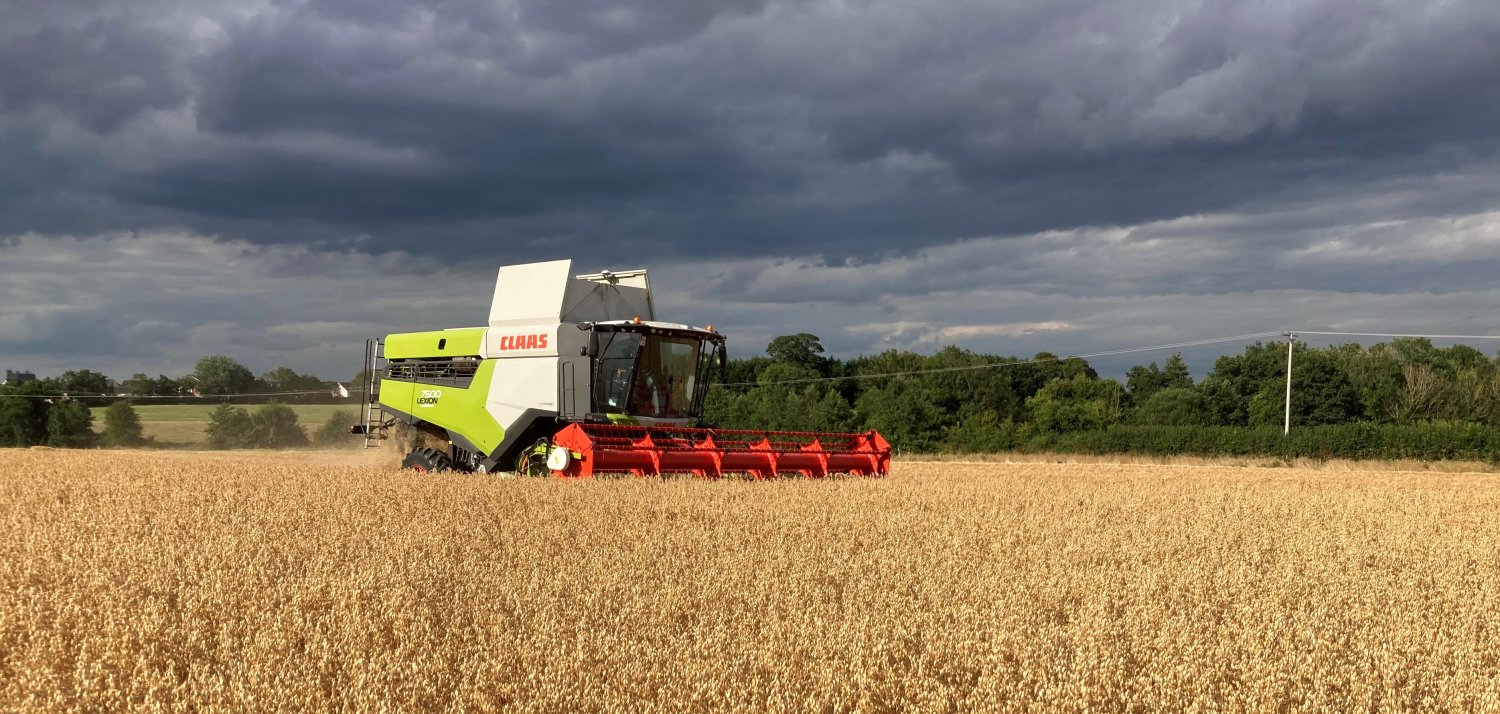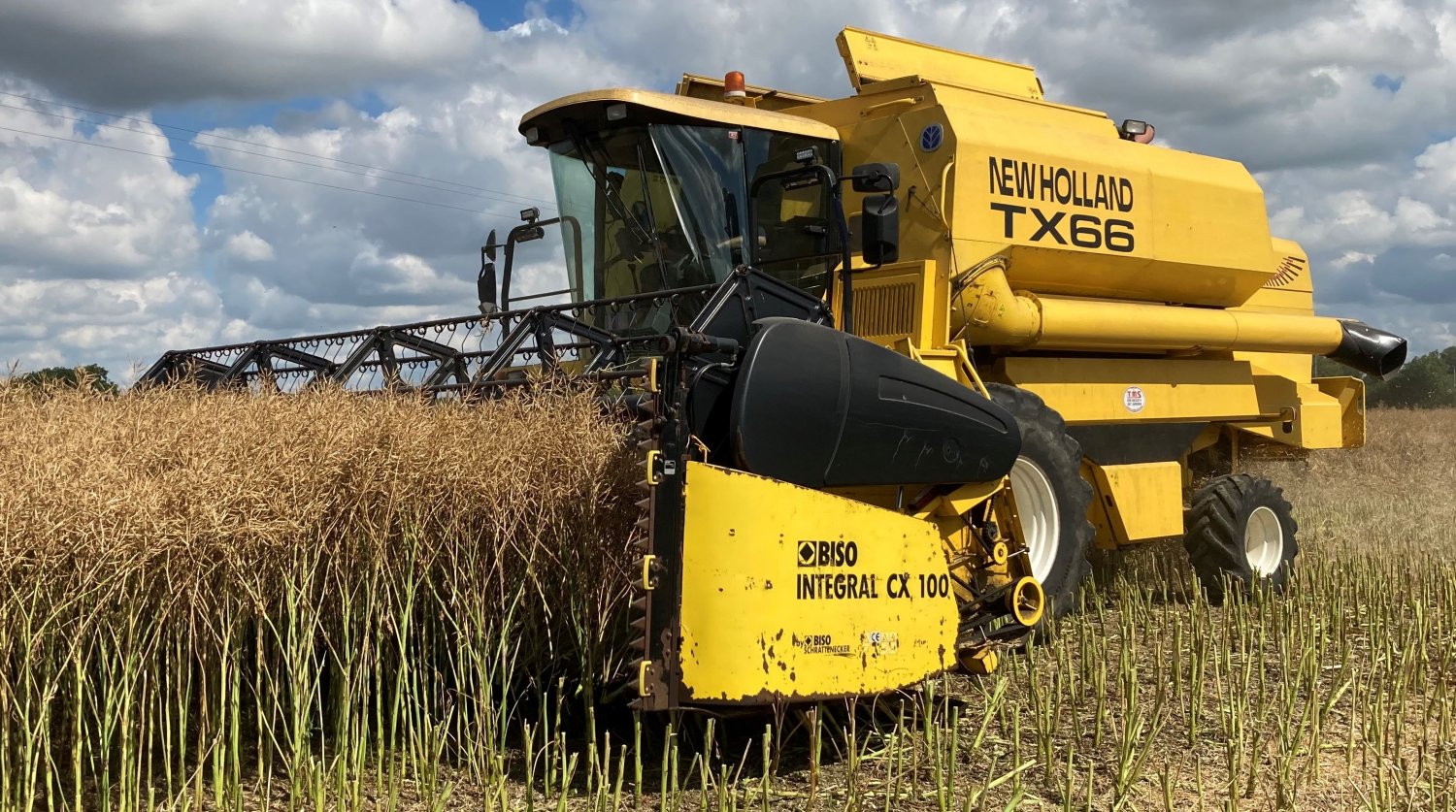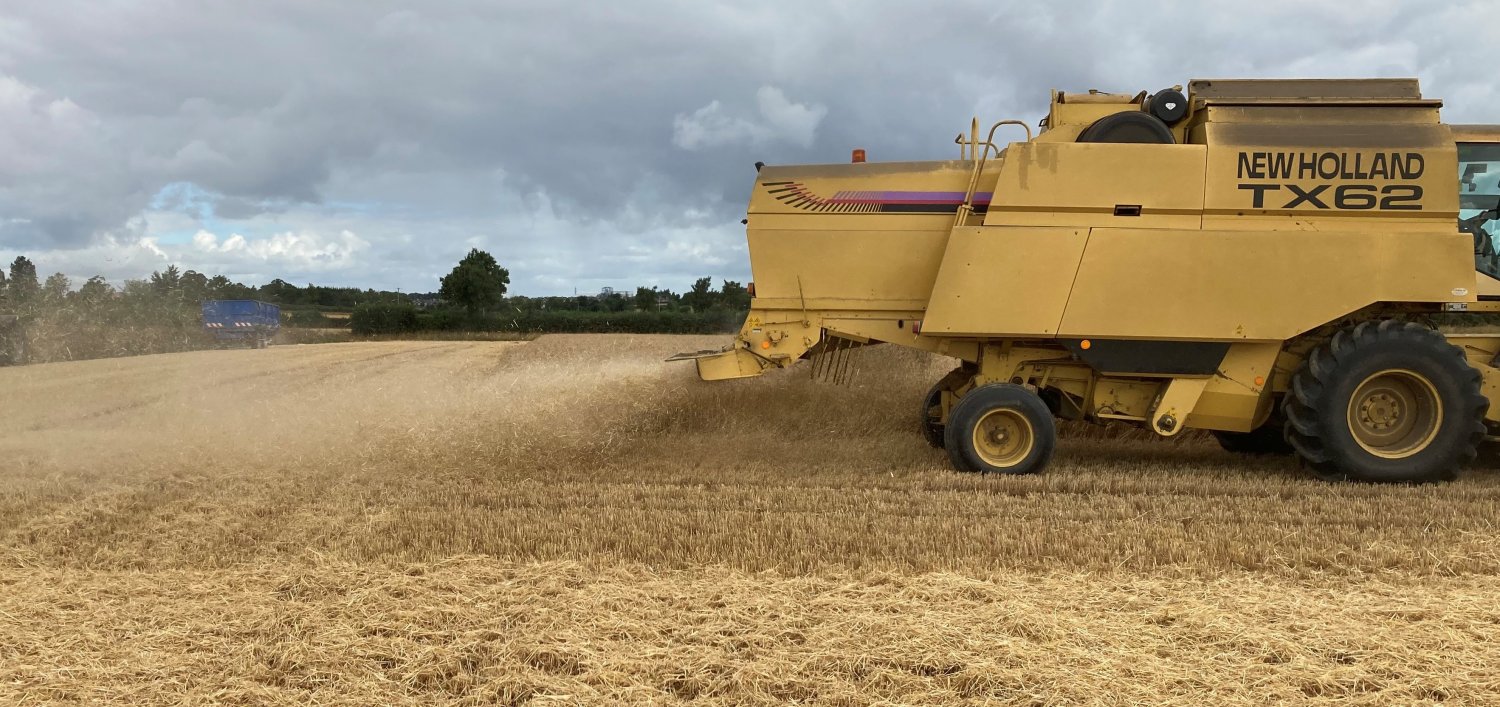
Teagasc Crop Report
Harvest Report 2022
Harvest Report 2022

To view the full report you must have an existing account with Teagasc ConnectEd.
Farmers sign in hereAlready have a ConnectEd account? Connected Client or Teagasc staff log in here
Highlights
- Total cereal production increased by 4% in 2022 to 2.42 million tonnes.
- There was an overall increase in tillage area in 2022. Cereal area increased by 4.3%, winter oilseed rape increased by 45% and the total area of beans, including winter bean crops, was 11.5% higher than 2021.
- A record year for yield in spring barley, winter oilseed rape and spring oats.
- Average spring barley yield in 2022 was 8.1t/ha which is the highest recorded yield for the crop surpassing the previous record of 8.0t/ha in 2019 and the 7.9t/ha recorded in both 2019 and 2021.
- A record yield of 5.1t/ha was recorded in winter oilseed rape which is 0.6t/ha above the 5 year average.
- Average yield of spring oats was 7.9t/ha which is the highest yield recorded for spring oats exceeding the previous record of 7.7t/ha set in both 2021 and 2019.
- Average yield of winter wheat was 11.0t/ha which equals the previous wheat record set in 2015.
- Weather conditions at harvest were excellent and all crops were harvested at lower than average moisture content. Yields are recorded at harvested moisture content.
- BYDV and Take all impacted on winter barley yield in southern and coastal counties but overall average winter barley yield was only 0.22t/ha below the 5 year average yield of 8.9t/ha with the average reflecting higher yielding crops in other parts of the country.
- Yield and quality of straw was excellent this season and straw was saved without addition cost due to excellent harvest weather. The straw market was back slightly on 2021 but the Straw Incorporation Measure (SIM) was very successful with a very high level of uptake in the scheme.
- It is estimated that the winter cereal area for 2023 has reduced by in excess of 30,000 ha due to unfavourable weather conditions this autumn.
- The area of winter oilseed rape is estimated to have increased to 19,000 ha due to a combination of an early finish to the harvest, planting opportunities in late August and a strong market for oilseeds.
| Crops | 20221 Area ('000) ha |
2021* Area ('000) ha |
Diff |
% Diff * | 2022** Av. Yield (t/ha) |
2021* Av. Yield (t/ha) |
2022 $ Production '000 t |
2021* Production '000 t |
Diff '000 t |
% Diff |
|---|---|---|---|---|---|---|---|---|---|---|
| W. Wheat | 60.3 | 56 | 4.3 | 8 | 11.01 | 10.8 | 631 | 575 | 56.2 | 10 |
| S. Wheat | 6.7 | 6.0 | 0.6 | 11 | 7.91 | 8.21 | 50 | 47 | 3.1 | 7 |
| W. Barley | 73.6 | 67.3 | 6.3 | 9 | 8.68 | 9.42 | 607 | 602 | 4.8 | 1 |
| S. Barley | 116.7 | 116.1 | 0.6 | 1 | 8.10 | 7.89 | 898 | 870 | 28.0 | 3 |
| W. Oats | 15.0 | 13.9 | 1.1 | 8 | 9.20 | 9.32 | 131 | 123 | 8.4 | 7 |
| S. Oats | 13.1 | 14.4 | -1.3 | -9 | 7.90 | 7.72 | 98 | 106 | -7.3 | -7 |
| Total Cereals | 285 | 274 | 11.7 | 4.3 | - | - | 2416 | 2323 | 93.2 | 4 |
| WOSR | 14.5 | 10 | 4.5 | 45 | 5.1 | 4.5 | 70 | 43 | 27.5 | 64 |
| S. Beans | 9.3 | 8.6 | 0.7 | 8 | 6.1 | 5.2 | 54 | 43 | 11.1 | 26 |
Notes;
1 Preliminary DAFM BPS figures
* CSO 2021 Area, Yield and Production of Crops
** Teagasc estimates
$ Yields x Utilisable Area (Area x 0.95)
Winter Wheat
The area of winter wheat was 60,332 ha which was an increase of 4,268 ha on 2021 and 7,000 ha over the 5 year average of 53,200 ha.
Average yield was 11.0t/ha which equals the previous wheat record set in 2015. This years yield is 1.1t/ha over the five year average yield for winter wheat of 9.9t/ha. Some expectational individual yields were recorded with reports of individual fields producing in excess of 14t/ha.
Excellent sowing conditions last autumn and a good growing season contributed to the excellent wheat yields this year. Disease levels were below average this year which was helped by a reduced area of varieties susceptible to yellow rust and good spraying conditions at critical spray timings.
Harvest conditions were excellent and crop losses were minimal. Grain moisture was below average at 16.4% and hectolitre weight was 75.4 kg/hl with individual crops exceeding 80 kph.
Spring Wheat
The area of spring wheat was similar to 2021 at 6,688 ha which is close to the 5 year average of 6,340 ha.
Almost all spring wheat was planted in March and benefited from and excellent growing season where disease levels were low. Excellent harvest conditions resulted in an earlier than normal harvest where many crops were harvested in late August/early September. Average yield was 8.1 t/ha which is above the 5 year average of 7.74 t/ha.
Grain quality was excellent with average grain moisture recorded at 17.4%.
Winter Barley
The area of winter barley increased by 9% to 73,605 ha due to the favourable planting conditions in the autumn of 2021. BYDV was evident in southern and coastal counties and take all also impacted on yield in susceptible sites. Above average temperatures in autumn/winter contributed to the increase in BYDV and Take all this season with aphid flight recorded in December at the Cork Teagasc suction tower. Data from Met Eireann shows that winter 2021/2022 was the 6th warmest in 123 winters.
Average yield was 8.68 t/ha, a decrease of 0.74 t/ha from 2021 and 0.22t/ha below the 5 year average of 8.9t/ha. Some of the lowest yields recorded were in southern and coastal counties, Cork, Wexford and Wicklow, indicating the impact of BYDV on yield. Highest yields in 2022 were recorded in the midlands and north east.
Most crops were harvested at very low moistures, with some harvested as low as 12-13%. Grain quality was variable depending on the level of BYDV and take all present in the crop. Average kph recorded was 65.2 kg/hl, with average harvest grain moistures at 15.5%.
Spring Barley
Average spring barley yield in 2022 was 8.1t/ha which is the highest recorded yield for the crop surpassing the previous record of 8.0t/ha in 2019 and the 7.9t/ha recorded in both 2019 and 2021. Most areas reported yields in excess of 10t/ha for individual crops. Crops were harvested in very good conditions and losses at harvest were minimal. Grain moisture averaged 16.2% and average hectolitre weight was 65.4 kg/hl.
The area planted of 116,693 ha was similar to the previous year and slightly below the 5 year average yield of 119,700 ha. The tillage incentive scheme was a big factor in the maintenance of the area as a decrease would have been expected following the large area of winter barley sown the previous autumn.
The majority of the crop was planted in the second half of March in good conditions. Spring growth was excellent resulting in some very thick crops. Lodging was confined to a small area and helped by favourable weather. Disease levels were low but net blotch and rhynchosporium were present where fungicide application was delayed.

Winter Oats
The area of winter oats was 15,040 ha which is an increase of 1,162 ha over 2021 and above the 5 year average of 12,800 ha. A mild winter and good growth in the spring resulted in forward crops in March and April. There were some cases of distorted leaves as a reaction to late frosts but the number of crops affected was low. Disease levels were relatively low as a result of the dry weather with the exception of some crown rust in the south.
Average yield was 9.2t/ha which is just behind the record yield of 9.32t/ha recorded in 2021. The 5 year average yield for winter oats is 8.7t/ha. Average grain moisture was 16.6% and average specific weigh was 55.4 kg/hl.
Spring Oats
Spring oats is the only cereal crop that had a reduced area when compared to 2021. The area decreased by 9% to 13,061 ha which is a reduction of 1,354 ha but the overall oats area remained the same as 2021 at slightly over 28,000ha.
Establishment was excellent and foliar disease levels were very low.
Average yield was 7.9 t/ha which is the highest yield recorded for spring oats exceeding the previous record of 7.7 t/ha set in both 2021 and 2019. Average specific weight was 54.6 kg/hl, with average grain moisture 17%.
Winter Oilseed Rape
The area of winter oilseed rape increased to 14,514 ha which represents a 45% increase over 2021. It is the largest area of the crop grown in Ireland since 2012 when 17,500ha was planted.
The majority of winter oilseed rape was planted in late August/early September and the mild winter/autumn contributed to excellent growth in that period. As a result most crops had very large canopies in the spring which enabled farmers to make significant reductions in chemical nitrogen applications. Despite the large canopies foliar disease levels were low.
A record yield of 5.1t/ha was recorded which is 0.6 t/ha above the 5 year average. Dry warm weather at harvest resulted in some very low moistures where the average was 9.7%.

Beans
The area of spring beans in 2022 is 9,273 ha. This is an increase of 650 ha from 2021 but well below the record area planted in 2020 of 12,526 ha. The winter bean area increased by 410ha to 1,004 ha.
There was a large variability in yield with the average at 6.1t/ha. This is 0.6 t/ha above the 10 year average of 5.5 t/ha. The highest average yield in the last 10 years was 6.7 t/ha in 2017 and a lowest average yield of 2.5 t/ha in the drought ridden season of 2018. There was a large variability in yield across the country with individual fields yielding up to 8.2t/ha and lower yields down to 3.5t/ha. Average moisture was 16.8%. Harvest was earlier than normal with some crops harvested in early September and the reminder later in the month after a break in the weather.
The majority of beans were sown in early March. Establishment was good and pest damage from bean weevil was lower than average. Chocolate spot was evident but generally did not impact on yield.
Protein payment for 2022 is €300/ha.
Straw
The Straw Incorporation Measure (SIM) was available again this year to support Irish tillage farmers who decided to chop and incorporate straw into the soil. Final details on the number of applicants are not available yet but uptake of the scheme was high and it is expected that the area chopped and incorporated increased this year. Payment rates of €250/ha for oats, rye, wheat or barley, are available and €150/ha for oil seed rape.
Straw quantities were good in all cereals and dry harvest weather allowed farmers to bale or incorporate straw without additional cost.
The straw market was strong again this year with 4 X 4 round bales making €15 - 18/bales ex field.

Winter Crop Planting
The estimated area of cereals planted this autumn is lower than the previous two season mainly due to challenging weather conditions this October. The largest reduction in area is in the South but the area of cereals in the North East is near normal. Winter barley area has suffered the greatest reduction in area. Weather is a major factor in the reduced area of winter barley but farmer reaction to poorer yields in the South and the excellent performance of spring barley this season are also factors in the reduced area. There is no crop diversification requirement (2-3 crop rule) for 2023 and this may also have had an impact on the level of planting.
The largest percentage reduction is winter oats but it is likely that the area of spring oats will increase to compensate.
The area of winter oilseed rape is estimated to be 19,000 ha which would be the largest ever area of the crop. An earlier finish to the harvest and a strong market for oilseeds are major factors in the increased area.
The area of winter rye increased to 2,700 ha in 2022 and it is expected that this area will be maintained for 2023. The area of winter beans increased to 1,000ha in 2022 but planting opportunities will determine if this area will be retained.
| 2020 | 2021 | 2022 | 2023 | |
|---|---|---|---|---|
| Wheat | 35.4 | 56.1 | 60.3 | 55 |
| Barley | 51.3 | 67.3 | 73.6 | 52 |
| Oats | 8.2 | 13.9 | 15.0 | 8 |
| Oilseed Rape | 8.7 | 10.0 | 14.5 | 19 |